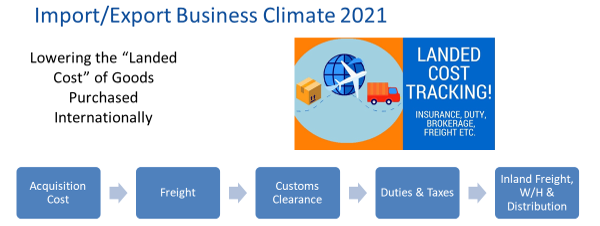By Thomas A. Cook, Managing Director, Blue Tiger International

The Covid-19 pandemic brought significant increases in logistics costs and supply chain spend, along with limitations on service both domestically and internationally.
Initial predictions pegged the disruption to continue into the second quarter of 2021 with a residual impact lasting until December 2021. Unfortunately, those predictions were overly optimistic. Now, as we near the end of 2021, transportation models are forecasting the return to normal to be out as far as Q3 2022. That is the timeframe that the supply-demand balance should return to near normal equilibrium.
Transportation costs, however, are unlikely to return to pre-pandemic levels. While the eight-fold increase in both surface and air transport that we have seen in 2020-2021 will taper, costs are likely to stabilize at a level approximately twice what they were in 2019. Those engaged in budgeting for supply chain costs should plan accordingly.
In addition to transport costs, we have seen warehousing, distribution and all related costs continue to escalate well into 2021 due to limitations on space and capacity. Cost declines in those areas will be slow to non-existent.
With a new normal of significantly higher baseline costs, it is critical to ensure that your supply chain process is tight – to avoid further costs and unexpected loss. Here are the six steps that define basic best practices in transport, logistics, and trade compliance.
The Six Steps
The following six steps originate from the author’s 35 years of experience in moving freight around the world and in assisting corporations with global logistics that are cost effective and reduce risk for themselves and their clients.
- Cho0se the Best INCO Term
- Insure the Shipment
- Choose the Right Freight Forwarder and Carrier
- Track all Shipments Proactively
- Understand the Total “Landed Costs”
- Be Trade Compliant!
Choose the Best INCO Term
The INCO Term, established by the International Commerce Commission, is followed by all countries belonging to the United Nations for goods that pass through international borders.
INCO Terms typically get updated every ten years as was demonstrated in January 2020.
There are 11 Options in the 2020 Edition.
The seven Incoterms® 2020 rules for any mode(s) of transport are:
EXW Ex Works (insert place of delivery)
FCA Free Carrier (Insert named place of delivery)
CPT Carriage Paid to (insert place of destination)
CIP Carriage and Insurance Paid To (insert place of destination)
DAP Delivered at Place (insert named place of destination)
DPU Delivered at Place Unloaded (insert of place of destination)
DDP Delivered Duty Paid (Insert place of destination)
[Note: the DPU Incoterms replaces the old DAT, with additional requirement for the seller to unload the goods from the arriving means of transport.]
The four Incoterms® 2020 rules for Sea and Inland Waterway Transport are:
FAS Free Alongside Ship (insert name of port of loading)
FOB Free on Board (insert named port of loading)
CFR Cost and Freight (insert named port of destination)
CIF Cost Insurance and Freight (insert named port of destination)
The INCO Term is a term of sale between a seller and a buyer that picks a point in time in the transaction where risk and cost is transferred from one party to the other. It does not address other contractual concerns, such as payment method, title, and details of marine insurance.
What it really does is advise an exporter at what time and place in a transaction it is responsible for cost and risk …. and conversely where the importer takes over responsibility.
Depending upon the INCO Term utilized, the risks and costs could be dramatically impactful for either the seller or the buyer.
We recommend that all operations, purchasing, and sales personnel learn at a detailed level all they can about INCO Terms and more specifically how to best leverage the term to reduce risk and cost in their transactions.
Insure the Shipment
The typical importer and exporter never worry about loss or damage until it occurs. And at that point everyone from the forwarder to the carrier is blamed for the occurrence. The truth is, when you ship frequently and all over the world, at some point in time freight will get lost or damaged.
It is critical to make sure that you first identify through the purchase or sales contract who has risk of loss or damage. What INCO Term is being utilized? How payment is being made?
Once the risk is understood, then marine cargo insurance should be acquired on an “All Risk”, Warehouse to Warehouse” basis with a reputable international cargo insurance underwriting company.
Additionally, the following loss control elements need to be considered and mirrored in the insurance policy:
- That the freight is packed, marked, and labeled well.
- That a responsible forwarder and carrier is utilized.
- Freight needs to pass through the system quickly. Delays at border points open the door for loss and damage.
- Freight needs to clear customs thoroughly, legally, timely, and following all import regulations. All those factors mitigate the potential for loss and damage.
Choose the Right Freight Forwarder and Carrier
As an extension of your shipping personnel, the Forwarder and Carrier take responsibility to move your freight through the global system. They need to do this in a manner that is timely, safely, and cost-effectively.
Choosing the right company who is qualified and who are experts in household products distribution is critical in making sure the shipment, the freight and the logistics move your package to you or your customer’s satisfaction.
With over 35 years’ experience, Blue Tiger International has developed key relationships with an array of freight forwarders and carriers and can assist you in making sure you have all the necessary information to make the best choices. Other organizations like the NCBFAA, AFA and TIA are all freight trade associations can produce members who specialize in the housewares industry vertical.
Track all Shipments Proactively
Making sure shipments arrive on time and in workable condition is the guarantee of customer satisfaction, long term relationships, fewer headaches, and greater margins.
This can be a service your freight forwarder or carrier provides, but it needs to be clearly identified in that vein and it must be done proactively, through every step of an international shipment.
Depending upon distances involved, countries of export and import, choices of mode and carrier … some freight can travel 12,000 miles, through 4-5 carrier handoffs, via several customs authorities and in several modes of transit.
Such complexity creates exposure to loss, damage or delay, all of which we want to avoid, since they lead to loss of revenue, customer dissatisfaction and untold stress within your organization.
To mitigate this concern, you need to structure a proactive system to “track and trace” all your international shipments through all the configurations, hand-offs and modes of transit.
Many “track and trace” systems can be electronic and advise you on all your shipping activity through web portals, emails and other electronic means.
The benefits of a proactive mindset in lieu of a reactionary one will pay off in spades over the course of time and client relationships.
Understand the Total “Landed Costs”

Landed Costs are the total of all the accumulated expenses attached to a shipment moving internationally.
- International Freight
- Duties, Taxes and Fees
- License Charges
- Handling Charges
- Domestic Freight
- Clearance and Handling Charges
- ISF Fees
- Carrier Surcharges
- Demurrage
- Storage and Warehousing
Sometimes the landed costs can exceed the value of the actual shipment.
In order to protect margins and profits, it is critical that you thoroughly understand what the “landed costs” are for your shipment, and that all cost elements are included in transactions. Only then can you make sure these costs are covered in the eventual client invoicing that will follow.
Remember, no one likes surprises … particularly those that have an additional price tag attached to them.
Be Trade Compliant!
It is imperative that both importers and exporters operate their global supply chains trade compliantly. This means following procedures and operational practice that incorporate the following:
- Due diligence
- Reasonable Care
- Supervision and Control
- Engagement
Trade compliance includes understanding the regulations and building internal SOP’s to comply with the regulations. Train personnel on how to interpret and practice the SOP’s and in a regulatory manner.
Engage in government programs that provide evidence of managing secure and compliant global supply chains, such as C-TPAT, Customs Trade Partnership Against Terrorism. C-TPAT is a voluntary program of security created for importers into the United States managed by Customs Border and Protection (CBP) and is now open to include exporters from the USA.
Areas also included in trade compliance have to do with documentation, classification (HTSUS/Schedule B Number(s), Valuation, Record Keeping, Export License Requirements, Denied Party Listing – to name a few of the operational concerns.
The penalties for non-compliance are fines, penalties and potential loss of import or export privileges. More serious areas can include criminal prosecutions.
Summary
Importing and exporting products successfully means paying attention to detail. The six areas outlined above are a good foundation for creating a detailed and comprehensive approach to managing global supply chain responsibilities.
Our years of global supply chain experience have demonstrated that those companies that are diligent about how they manage the freight, logistics and distribution of household products will create the best opportunity to:
- Protect margins and grow profits
- Increase customer satisfaction
- Decrease stress and problem areas in global markets
- Better their reputation, which converts to client retention and expansion
Thomas A. Cook is a 30-year seasoned veteran of global trade and Managing Director of Blue Tiger International, based in New York, LA and West Palm Beach, Florida.



